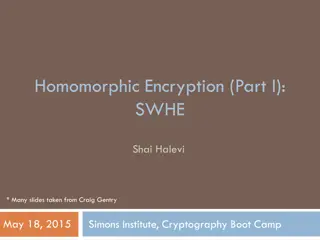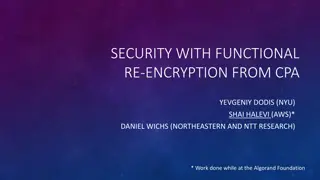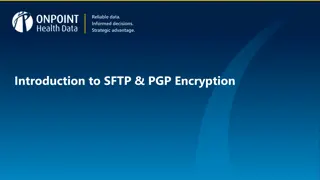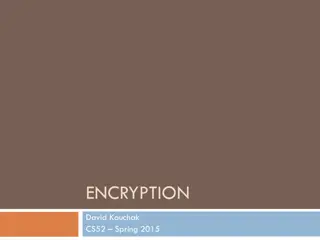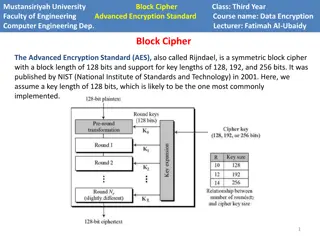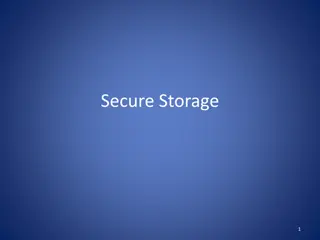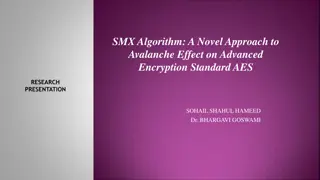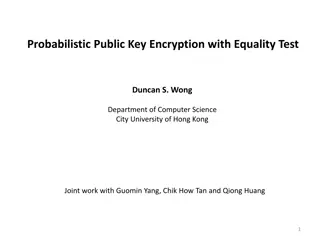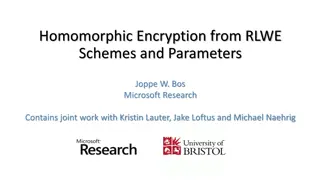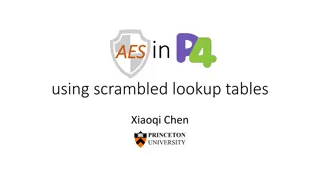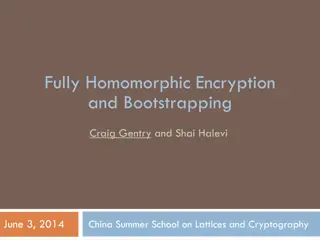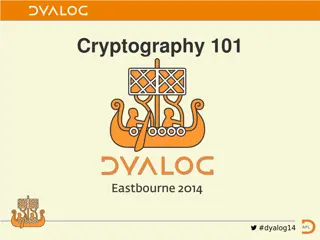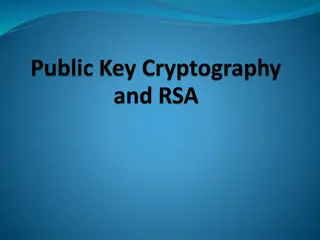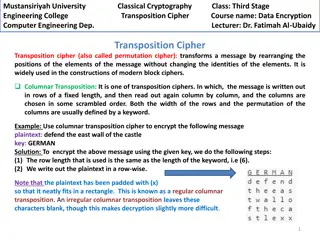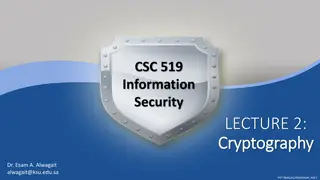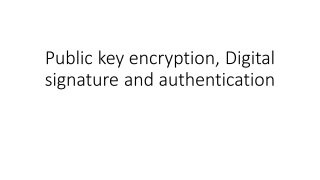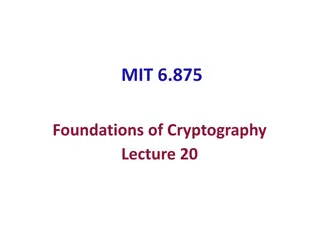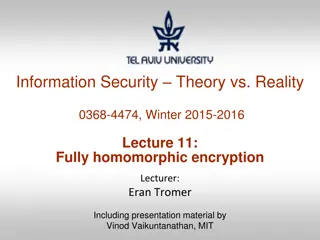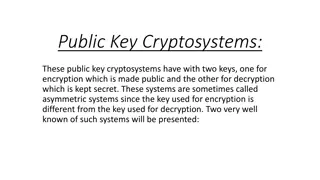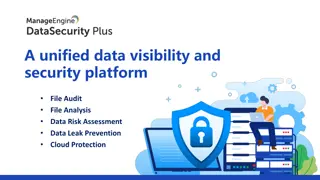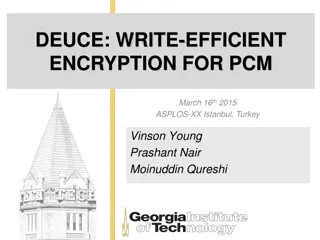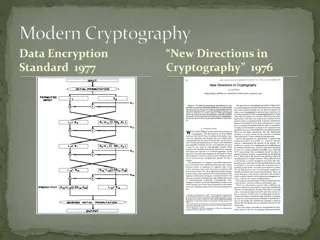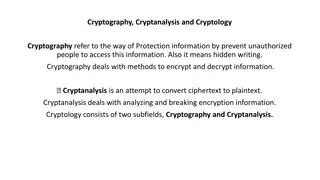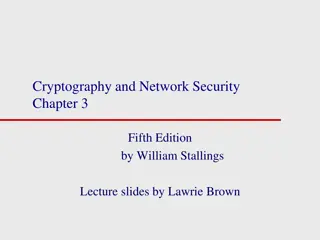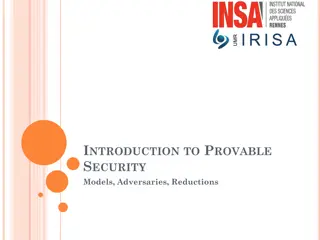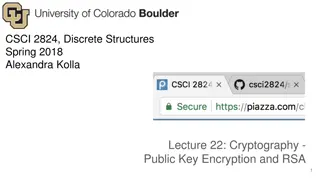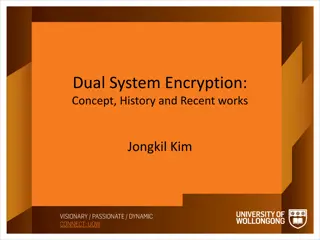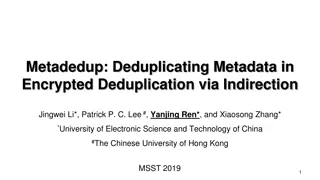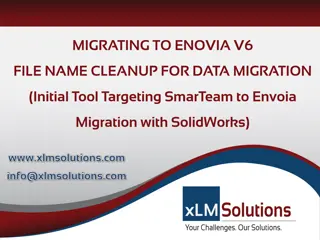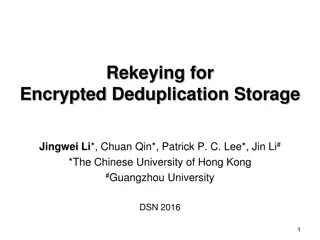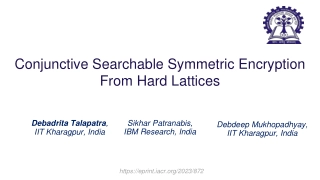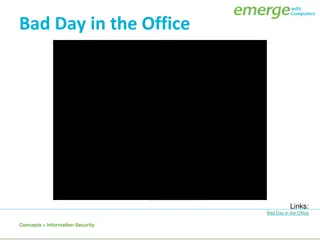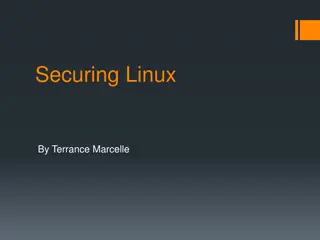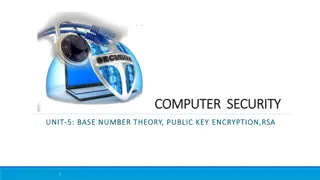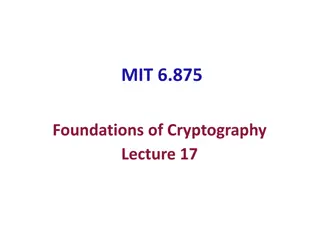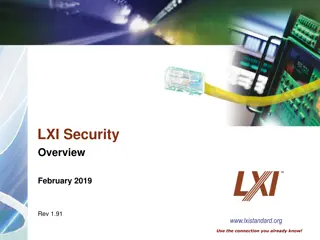Understanding Data Encryption and File Security
Exploring data encryption and file security, covering topics such as scenarios for encryption, file encryption methods, limitations, and secure file deletion techniques. Highlighting the challenges of balancing security, usability, and reliability in computer systems.
Download Presentation

Please find below an Image/Link to download the presentation.
The content on the website is provided AS IS for your information and personal use only. It may not be sold, licensed, or shared on other websites without obtaining consent from the author. Download presentation by click this link. If you encounter any issues during the download, it is possible that the publisher has removed the file from their server.
E N D
Presentation Transcript
Encrypting stored data Tuomas Aura T-110.4206 Information security technology Aalto University, autumn 2013
Outline 1. Scenarios 2. File encryption 3. Encrypting file system 4. Full disk encryption 5. Data recovery Simple application of cryptography but a good example of how difficult it is to build secure system [Acknowledgement: These slides are partly based on Microsoft material.] 2
Data encryption Scenarios: lost and stolen laptop computers stolen servers decommissioning hard disks Risk of disclosure of confidential data The obvious solution: encrypt data on disk But computer security is never quite so simple: Security often conflicts with usability Security often conflicts with reliability; plan for data recovery is needed System design mistakes or programming errors could compromise data 4
Simple file encryption 1. User enters passphrase Passphrase hashed with a cryptographic hash function to produce a key File encrypted with the key E.g. AES in CBC mode Decryption with the same key Examples: crypt(1), GPG 1 2. ***** ** SHA-1 3. 2 d70f3 619a 209b Our plan is. 3 % gpg --output ciphertext.gpg --symmetric plaintext.doc Enter passphrase: 6
Limitations of file encryption Encrypting a file normally creates an encrypted copy; what happens to the old plaintext file? No guarantee that the plaintext is not left on the disk Word processors and other software create temporary files and backup copies Unencrypted versions and fragments of the file may be left in locations that the user does not even know about There are tools for deleting temporary files and for wiping free disk space, but none is completely reliable Cloud storage keep all old data
Wiping files Deleting a file simply marks the space free but does not erase the contents: raw data is still on the disk Overwriting a file does not always erase the old contents: File system may organize data in unexpected ways: backups, revision control, copy on write, journal, etc. Solid state disks (SSD) write in complex patterns Wiping all empty disk space by overwriting Deletes most data but no guarantee Disk drive behavior is not always controllable by the file system driver: bad block replacement, optimizations Magnetic data remanence: magnetic medium may retain traces of previous contents even after overwritten Physical destruction: grinding disks, heating magnetic medium above Curie temperature Flash memory (SSD) fragments may retain data 8
Windows encrypting file system (EFS) Encryption is a file attribute Possible to enable encryption for all files in a folder new files encrypted Files are readable only when the user is logged in Encryption and decryption are transparent to applications Similar products exist for Unix 10
EFS key management *) DPAPI = Data Protection applicationprogramming interface Windows 1 User name: Password: Username ********* Log on to: Domain OK Cancel Shut Down... Options << PBKDF2 1. User logs in, enters password Hashed to produce key Used to decrypt User s Master Key Used to decrypt User s Private EFS Key Used to decrypt File Encryption Key (FEK) Used to encrypt on write and decrypt on read 2 key 2. 3. User s DPAPI* Master Key 3 User profile 4. User s Private EFS Key 4 User profile 5. RSA 5 $EFS FEK alternate data stream 6. Plaintext file 6 Encrypted d70f3 619a2 09b15 Our plan is. File AES or 3DES 11
EFS limitations Encrypts contents of specific files only User login credentials (password) needed for decryption System has no access to encrypted files unless user logs in System cannot index files without the user password Backups contain encrypted files, not the plaintext When encrypting plaintext files, the original file is not wiped, just deleted; the data remains on the disk User should create files in an encrypted folder Transparent decryption e.g. data decrypted transparently when copying to a file share over network or to an un-encrypted FAT partition Some data is not encrypted: folder and file names temp files, earlier unencrypted versions, printer spool registry, system files and logs page file can now be encrypted but requires policy configuration Hibernation file may contain decryption keys 12
Full disk encryption Entire disk is encrypted: Protects all information on disk Easier to use correctly than EFS Products are available from various hardware and software vendors including hard disk manufacturers Password, key or physical token required to boot or to mount disk; thereafter transparent Usability and reliability issues? Requires user/admin to be present at boot time In software-based products: Password must be strong enough to resist brute-force guessing Hibernation is a problem Hardware solution would be better 17
Trusted platform module Trusted hardware enables some things that otherwise would be impossible Trusted platform module (TPM) is a smart-card- like module on the computer motherboard Holds crypto keys and platform measurements in platform configuration registers (PCR) Useful TPM operations: TMP_Seal: encrypt data in any platform configuration TPM_Unseal: decrypt the data, but only if the platform configuration is the same as when sealing
Windows BitLocker Full-volume encryption in Windows Uses TPM for key management Optional PIN input and/or USB dongle at boot time System volume must be NTFS, data disks can also be FAT Sealing the entire system partition: Encrypt data with a symmetric key Seal the key; store sealed key on disk; unseal when booting TPM checks the OS integrity before unsealing the key Can boot to another OS but then cannot unseal the Windows partition cannot bypass OS access controls For a stolen laptop, forces the thief to hardware attack against TPM 19
BitLocker partitions Windows partition contains: Volume metadata with MAC Encrypted OS Encrypted page file Encrypted temp files Encrypted data Encrypted hibernation file 1.5 GB Encrypted Windows partition Boot partition Boot partition contains: MBR OS loader Boot utilities
BitLocker keys Storage Root Key (SRK) inside TPM 1 2Volume Master Key (VMK) Encrypted keys in volume metadata Full Volume Encryption Key (FVEK) 3 Plaintext data 4 and bring milk Separate VMK/FVEK adds flexibility how?
Algorithms and key sizes Storage root key (SRK) is a 2048-bit RSA key Volume master key (VMK) is a 256-bit symmetric key Full volume encrypt key (FVEK) is a 128 or 256-bit symmetric key The disk in encrypted with AES-CBC Initialization vector (IV) derived from sector number No integrity check Adding a MAC would increase the data size Disk sectors are pre-processed with a proprietary diffuser algorithm Makes attacks against integrity more difficult; the whole sector is encrypted as if one cipher block (512..8192 bytes)
Secure boot with TPM Pre-OS Static OS Dynamic OS measure and load CRTM load volume metadata, unseal VMK, verify MAC1 on metadata, decrypt FVEK BIOS MBR NTFS boot sector decrypt, verify signature and load NTFS boot block Boot manager OS loader2 PCRs on TPM Windows 1MAC keyed with VMK. 2Different loaders for boot, resume etc.
Which PCR values are used? *PCR 00: CRTM, BIOS and Platform Extensions (PCR 01: Platform and Motherboard Configuration and Data) *PCR 02: Option ROM Code (PCR 03: Option ROM Configuration and Data) *PCR 04: Master Boot Record (MBR) Code (PCR 05: Master Boot Record (MBR) Partition Table) (PCR 06: State Transitions and Wake Events) (PCR 07: Computer-Manufacturer Specific) *PCR 08: NTFS Boot Sector *PCR 09: NTFS Boot Block *PCR 10: Boot Manager *PCR 11: BitLocker Critical Components If any of the *-values has changed, the decryption key will not be unlocked and a recovery password is needed BitLocker keys will be unlocked before OS upgrade
BitLocker modes TPM only: Unsupervised boot (VMK unsealed if the PCR values correct) Attacker can boot stolen laptop but not log in security depends on OS access controls Very attractive mode of operation enabled by TPM but see the following slides! TPM and PIN: TPM requires a PIN during the secure boot TMP will be locked after a small number of incorrect PINs Attacker must break the TPM hardware to decrypt the disk Attacker may also sniff communication between chips on a live system TPM (and PIN) and USB stick: Secure boot and strong keys on a physical token high security USB stick without TPM Traditional software-based full-disk encryption; no secure boot Network unlock Server can reboot if on the same network with AD 26
Cold boot attack Laptop memory is designed for low power consumption slow refresh rate data stays in memory for seconds after power loss Data remanence in DRAM: Pull out memory from a running computer and plug it into a reader Some bits will be random but some will retain their values might be possible to recover most bits of a cryptographic key in the memory Use cold spray or liquid nitrogen to reduce data loss Cold boot attack: Reboot into minimal hacker OS from USB stick or CD Memory power lost only for a fraction of a second during reboot memory contents almost unchanged Lessons: Breaks full-disk encryption if attacker has access to the running computer Sleeping laptop = running laptop most laptops vulnerable Breaks BitLocker in TPM-only mode even if it is powered down OS access controls, e.g. screen lock, do not stop a physical attacker 28
Need for data recovery If the decryption key is lost, encrypted files will be lost If Admin resets user password, EFS files cannot be read Password reset and hacking tools have the same effect User can change the password back to the old one if remembered Backup files become unreadable if the user s old (archived) private key s is lost Can happen when rebuilding or cleaning user profile BitLocker risks: installing Linux boot loader, replacing the motherboard, TPM boot PIN forgotten or mistyped many times, moving disk to another computer Good idea to backup decryption keys
Data recovery in EFS Windows domain has a data recovery agent (DRA) FEK is encrypted also with DRA public key Domain Admin is the default DRA Other DRAs can be defined in a Group Policy Standalone machine has no default DRA Latest password reset disk also recovers EFS private key User may also export the user s EFS certificate (including the private key) to a backup disk Local Admin can configure a DRA on the local machine (see cipher.exe) Questions: Win 2000 had Local Admin as default DRA fro non-domain machines; why was this not a good idea? Local Admin cannot read the users encrypted files without the user passwords; can the Admin get around this? 31
Data recovery in EFS File encryption key (FEK) is encrypted with one or more recovery agents public keys The same mechanism is used for sharing encrypted files between users Recovery Agent s Private EFS Key User s Private EFS Key FEK FEK File attribute Plaintext Plaintext file file d70f3 619a2 09b15 Encrypted Our plan is. Our plan is. File 32
Data recovery in BitLocker Recovery password: User can print a 48-digit recovery password or store it on a USB stick, CD or remote disk; it is actually a 128-bit key BitLocker encrypts the VMK with the recovery password and stores it with the volume metadata (in the same way as the TMP-sealed VMK) Multiple backups of volume metadata are stored in the volume in case a part of the volume is corrupted Organizational recovery policy: Windows Domain Admin can require the recovery password to be uploaded to the Active Directory Installing another OS for dual boot will trigger recovery User can accept the new boot configuration after entering the recovery password
Exercises What secure methods are there for erasing magnetic hard drives and tapes, USB stick or solid-state drives (SSD), and paper documents? How to delete a specific file from a computer securely without erasing the whole disk? What security properties does GPG file encryption or EFS provide that full- disk encryption does not? How vulnerable is EFS to password guessing? Why do EFS and BitLocker have so many levels of keys? Are some unnecessary? Compare the security of software-based full-disk encryption and the TPM approach against brute-force password guessing How to mitigate the risk of cold-boot attacks (both against BitLocker and more generally)? Explain what effect do powering down the laptop computer, hibernation and sleep mode have on the cold boot attack? Transparent operation (happens without the user or application even knowing) improves usability of data encryption, but are there risks associated with the transparency? How would you design the encryption of files in cloud strorage? 34
Related reading Online: Halderman et al., Lest We Remember: Cold Boot Attacks on Encryption Keys. http://citp.princeton.edu/memory/ Stallings and Brown: Computer security, principles and practice, 2008, chapter 10.5 35


